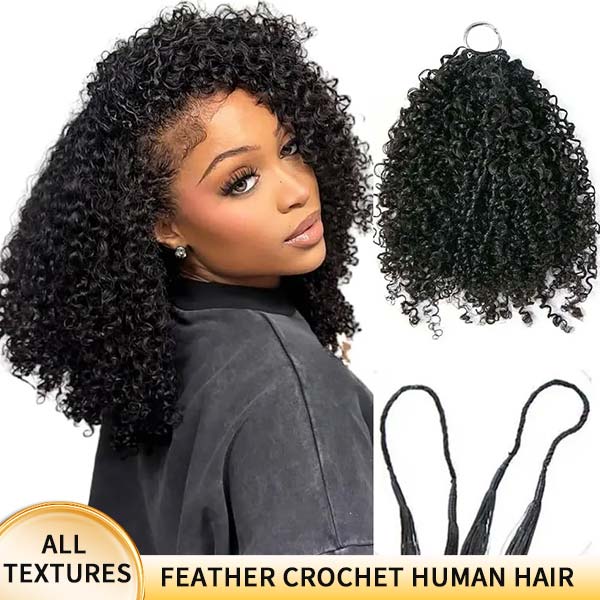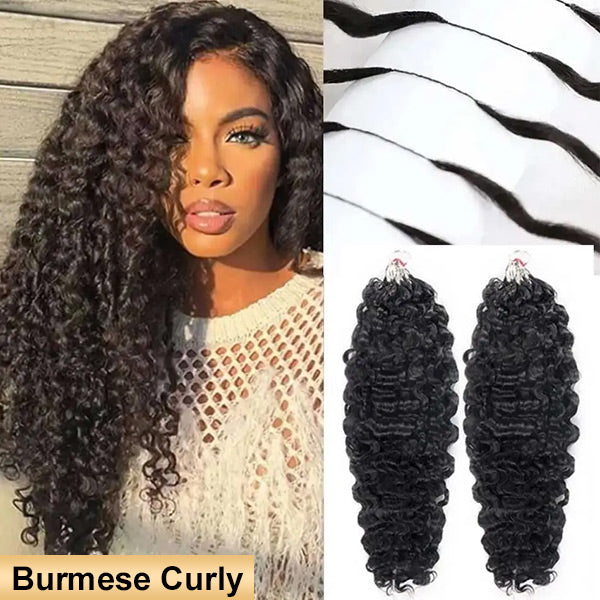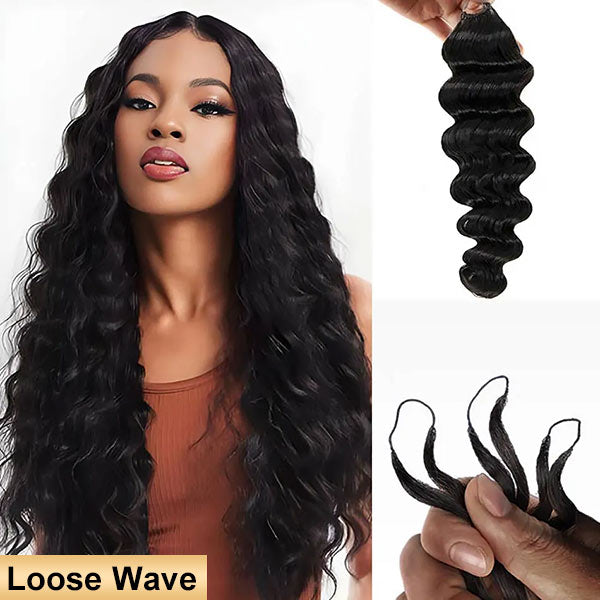Cornrows, sometimes called canerows, are a style of traditionally three-strand braids, originating in Africa, in which the hair is braided very close to the scalp, using an underhand, upward motion to make a continuous, raised row. Cornrows are a timeless and versatile hairstyle that holds significant cultural importance.
Choosing the right hair type for cornrows can greatly impact the style's appearance, durability, and overall health of the hair. This article aims to provide an in-depth look at the best hair types for cornrows. Whether you’re considering traditional cornrow braid styles or tribal braids, this guide will help you make informed decisions.
Characteristics of Ideal Hair Types for Cornrows
- Hair Texture and Type
The texture and type of hair play a crucial role in determining how well it will hold cornrows. Hair that has natural curl or coil patterns generally holds braids better and longer. This is due to the texture providing natural grip and support to the braids, reducing slippage and maintaining the style's integrity. Coarser hair types, like Type 4, have a naturally tighter curl pattern that holds cornrows more securely, while looser curl patterns, like Type 2 or 3, may require more product to maintain the style.
- Hair Length and Strength
Hair length and strength are important factors for achieving neat and long-lasting cornrows. Ideally, hair should be long enough to braid without causing excessive tension on the scalp, which can lead to breakage. Strong, healthy hair is less likely to suffer damage during the braiding process. It's recommended that hair be at least three to four inches long for effective cornrowing. Strong hair withstands the tension from braiding and styling without breaking, ensuring that the cornrows stay intact for longer periods.

- Natural Moisture Levels and Elasticity
Hair with good moisture levels and elasticity tends to handle the braiding process better. Moisturized hair is more flexible, reducing the risk of breakage during styling. Elasticity ensures the hair can withstand the tension of cornrows without snapping. Maintaining proper moisture balance is crucial, as dry hair is more prone to breaking and fraying. Using hydrating products and deep conditioning treatments can significantly improve the hair's moisture retention and elasticity, making it more suitable for cornrows.
Best Hair Types for Cornrows

Type 4 Hair (Kinky/Coily)
- Natural Suitability for Cornrows: Type 4 hair, characterized by its tight coils and kinks, is naturally suited for cornrows. The texture provides excellent grip, making it easier to create and maintain intricate patterns. Type 4 hair includes subcategories like 4A, 4B, and 4C, each with varying curl tightness. These tight curls and coils provide a natural anchor for the braids, ensuring they stay neat and last longer.
- Benefits and Considerations: Although type 4 hair naturally provides excellent grip for cornrows, and cornrows generally retain moisture well. However, type 4 hair does require more hydration to prevent dryness and brittleness, It's essential to keep the hair moisturized and reduce frizz. Regularly using a leave-in conditioner and natural moisture spray can help keep Type 4 hair healthy and manageable.
Type 3 Hair (Curly)
- Adaptability and Maintenance: Type 3 hair, with its loose curls, is also suitable for cornrows. The curls offer enough texture to hold the braids securely while providing a smooth appearance. This hair type includes 3A, 3B, and 3C, with varying degrees of curl tightness. Type 3 hair is versatile and can be styled into various cornrow patterns, from simple straight-back styles to more intricate designs.
- Benefits and Considerations: While Type 3 hair can hold cornrows well, it may require more frequent moisturizing to prevent frizz. Using a light oil or leave-in conditioner can help maintain the style. It's important to use products that enhance curl definition and provide moisture without weighing down the hair. Regular deep conditioning treatments can help keep Type 3 hair healthy and ready for cornrowing. Additionally, incorporating a hydrating curl cream can help maintain the curl pattern and reduce frizz.
Type 2 Hair (Wavy)
- Adaptability and Styling Tips: Type 2 hair has a wavy texture that can be braided into cornrows with proper preparation. The waves offer some natural grip, but additional products may be needed to keep the braids intact. This hair type includes 2A, 2B, and 2C, with increasing wave definition. Type 2 hair is generally smoother and less prone to frizz compared to curlier hair types, making it relatively easy to style into cornrows.
- Benefits and Considerations: Wavy hair might require more effort to keep the braids neat, as it can easily become frizzy. Using a setting spray or gel can help maintain the style's longevity. It's essential to use products that provide hold and reduce frizz without making the hair stiff. Regularly applying a lightweight leave-in conditioner can help keep Type 2 hair manageable and reduce flyaways. Additionally, using a smoothing serum can enhance the hair's natural waves and keep the cornrows looking neat.
Type 1 Hair (Straight)
- Special Care and Preparation: Type 1 hair is straight and lacks natural texture, making it the most challenging type for cornrows. However, with the right techniques, straight hair can still achieve beautiful cornrows. This hair type includes 1A, 1B, and 1C, with increasing amounts of body and slight wave. Straight hair requires more effort to create and maintain cornrows due to its smooth texture.
- Benefits and Considerations: Straight hair requires special care, such as using a texturizing spray or braid gel to add grip. The braids might not last as long as those in curlier hair types, so regular maintenance is essential. It's crucial to use products that provide hold and texture without making the hair greasy or heavy. Regularly applying a light mousse or texturizing spray can help add volume and grip to straight hair, making it easier to braid. Additionally, using a fine-tooth comb to backcomb the roots slightly can provide extra grip for the braids.
Preparing Hair for Cornrows
Pre-Cornrow Cleansing Routine
Start with a clean slate by thoroughly washing your hair. Use a sulfate-free shampoo to avoid stripping natural oils, followed by a moisturizing conditioner. This helps remove any product buildup and ensures your hair is clean and ready for braiding. Clean hair provides a better base for cornrows, reducing the risk of scalp irritation and ensuring the braids last longer.
Deep Conditioning and Detangling
Deep conditioning is crucial to ensure your hair is hydrated and strong enough to handle the braiding process. Detangle your hair carefully using a wide-tooth comb to prevent breakage. Deep conditioning treatments help restore moisture and strengthen the hair, making it more resilient during the braiding process. Detangling reduces the risk of knots and tangles, making the braiding process smoother and more efficient.
Moisturizing and Protecting the Hair
Apply a leave-in conditioner or a light oil to keep your hair moisturized. This step is vital to maintain the health of your hair while it's in cornrows. Moisturized hair is more flexible and less prone to breakage, ensuring the braids stay intact and your hair remains healthy. Using a lightweight oil or leave-in conditioner helps lock in moisture and provides a protective barrier against environmental stressors.
Trimming and Selecting Suitable Products
Trim any split ends to prevent further damage. Choose products designed for braided styles, such as braid gels or holding sprays, to ensure your cornrows stay neat. Trimming split ends helps prevent further breakage and ensures the braids look clean and polished. Selecting the right products, such as moisturizing gels or holding sprays, helps maintain the braids and reduces frizz.
Proper Drying Techniques
Allow your hair to air dry or use a blow dryer on a low heat setting. Avoid using high heat, as it can cause dryness and damage. Proper drying techniques ensure your hair is fully dry before braiding, reducing the risk of scalp issues and ensuring the braids last longer. Using a blow dryer on a low heat setting helps speed up the drying process without causing excessive damage.
Maintenance of Cornrows
Regular Moisturizing and Scalp Care
Keep your scalp and braids moisturized by applying a light oil or braid spray. This helps prevent dryness and itching. Regular moisturizing keeps the scalp healthy and reduces the risk of flaking or irritation. Using a light oil or braid spray helps keep the braids looking fresh and reduces frizz. Regularly applying a moisturizing spray or oil helps maintain the braids' integrity and keeps the scalp hydrated.
Nighttime Protection and Gentle Handling
Protect your cornrows at night by wearing a satin or silk scarf or bonnet. This reduces friction and helps maintain the style. Handle your braids gently to avoid frizz and breakage. Nighttime protection helps prevent the braids from becoming frizzy and keeps them looking neat. Using a satin or silk scarf or bonnet reduces friction and helps maintain the style's longevity. Handling the braids gently reduces the risk of breakage and ensures the braids stay intact.
Maintenance Tips for Prolonged Style Longevity
Regularly check your cornrows for any loose strands and touch them up as needed. Avoid excessive manipulation and keep your scalp clean to extend the life of your cornrows. Regular maintenance helps keep the braids looking neat and extends their longevity. Checking for loose strands and touching up the braids as needed helps maintain the style's appearance. Keeping the
Proper Washing
While cornrows are a protective style, it's essential to keep them clean to maintain scalp health. Use a diluted shampoo to cleanse the scalp gently, followed by a conditioner. Rinse thoroughly to avoid product buildup, which can cause itching and flaking.
Touch-Ups and Repairs
Regular touch-ups are necessary to keep your cornrows looking fresh. Depending on hair growth and the style's integrity, touch-ups can be done every two to four weeks. This helps maintain the neatness of the braids and ensures the style lasts longer.
Avoiding Excessive Heat and Styling
Limit the use of heat styling tools on your cornrows. Excessive heat can damage both the natural hair and the braids. If you need to refresh your style, consider using low-heat settings or opting for heatless methods.
Scalp Care and Itch Relief
To alleviate scalp itching, use natural oils or a light scalp spray formulated for braids. These products can soothe the scalp and provide relief without causing buildup. It's important to choose products that are specifically designed for braided styles to maintain scalp health.

Benefits of Using Cornrow Wigs
Cornrow wigs offer the versatility of changing your hairstyle without the commitment of permanent braiding. They can be easily applied and removed, allowing you to switch styles frequently. This convenience is especially beneficial for those who enjoy experimenting with different looks.
- Protection for Natural Hair: Wearing cornrow wigs can protect your natural hair from the stress and manipulation associated with traditional braiding. This can help maintain the health and integrity of your hair, reducing the risk of damage and breakage.
- Style Variety and Customization: Cornrow wigs come in various styles, including straight-back cornrows, lemonade braids, and intricate tribal braids. This variety allows you to choose a style that suits your preference and complements your look. Additionally, these wigs can be customized to fit your head perfectly, ensuring a natural and comfortable fit.
- Time-Saving and Cost-Effective: Using cornrow wigs can save you time and money in the long run. Instead of spending hours at a salon, you can achieve the desired look within minutes. Moreover, investing in a high-quality cornrow wig can be more cost-effective than frequent salon visits.
Conclusion
Choosing the best hair type for cornrows involves understanding your hair's texture, length, and maintenance needs. Whether you have kinky, curly, wavy, or straight hair, proper preparation and care can ensure your cornrows look their best and last longer. Additionally, cornrow wigs offer a versatile and convenient alternative, allowing you to enjoy the beauty of cornrows without the commitment. Explore a wide range of braided wigs at mybraidedwig.com and embrace the elegance of this timeless hairstyle.
Related Articles:
How to Achieve a Youthful Look with Cornrow Braids?
























































